Never miss another geomagnetic storm. Sign up for Space Weather Alerts and you'll receive a text message when magnetic storms erupt. Aurora tour guides and professional astronomers use this service. You can, too! | | |
CHANCE OF FLARES TODAY: NOAA forecasters say there is a 55% chance of M-class solar flares and a 15% chance of X-flares today. Sunspots AR3169 and AR3176 both pose a threat for such explosions. Neither is directly facing Earth, but they're close enough for radio blackouts and glancing-blow CMEs. Solar flare alerts: SMS Text.
WHAT THE PULSE ACTUALLY LOOKED LIKE: "Ping" Wait 2 seconds. "Ping" Wait 2 seconds "Ping". That's what most ham radio operators heard yesterday when they received HAARP's radar transmission to asteroid 2010 XC15. Scott Tilley of Roberts Creek, British Columbia, took a closer look, and this is what he saw:
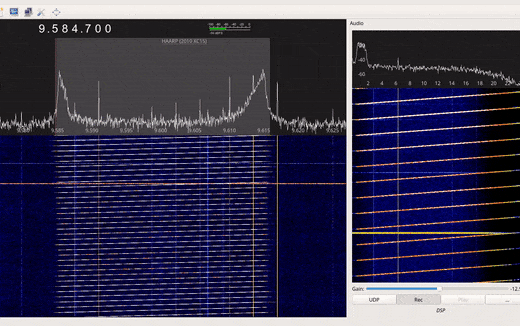
"The pulse was lopsided with a fast rise and a slow decay," notes Tilley. "I believe this is due to multipath propagation from HAARP in Alaska to my receiver in British Columbia."
Everyone who picked up the pulse did so because Earth's ionosphere reflected some of HAARP's radio energy back to Earth. Only a fraction escaped into space and reached the asteroid. Tilley's high-time-resolution recording of the pulse shows that multiple reflections (probably with a dash of ducting and refraction) were involved.
The complexity of the ionosphere, and how it modifies shortwave signals, is a key challenge for researchers who will be processing radar returns from asteroid 2010 XC15. Good luck to the radar team as we await their results!
ASTEROID RADAR SIGNAL RECEIVED BY HAMS: Yesterday, ham radio operators around the world picked up an unusual pulsing signal at 9.6 MHz. It was HAARP, pinging an asteroid. "I captured the transmission in New Mexico at 9.600 MHz and 9.585 MHz on two separate radios," reports Thomas Ashcraft. "It was pulsing every 2 seconds." Listen to Ashcraft's audio recording:

The same rhythmic pulse was heard across North America, Europe, and Australia. A selection of reports is listed below.
If the experiment worked, the pulses also reached asteroid 2010 XC15, which passed by Earth on Dec. 27th at a distance of 770,000 km. Researchers from NASA and the University of Alaska pinged 2010 XC15 with shortwave radio signals to probe the asteroid's interior--a first if it worked. We're still waiting for confirmation that the reflections were received, as expected, by antenna arrays in California and New Mexico.
Additional reports: from Marko Päätalo of Kaustinen, Finland (video); from Aub McKibben of Adelaide, Australia (audio); from Charlie Knutila/N7KN of Whidbey Island, Washington, USA (video); from Ron Masters in the midwestern USA (video); from Ed/LA5VUA of Drammen, Norway (audio); from Doug VanderClute/KB1MGL of Northfield New Hampshire, USA; (audio); from Bill Westphall/WB6YPF of Altadena, California, USA (audio);
More additional reports: from Jim Hale of central Virginia, USA (audio); from Ari Yleismies/OH3NU of Finland (audio, dynamic spectrum); from Thomas Carswell Jr/KT4WO of Whittier, NC, USA (audio); from Mark Willer of east Idaho, USA (audio); from François Théveneau of St Vincent de Tyrosse, France (audio, dynamic spectrum); from Dennis Williams/N0MND of Rapid City, South Dakota, USA (audio);
Realtime Space Weather Photo Gallery
Free: Spaceweather.com Newsletter
THE LIGHT CURVE OF COMET ZTF: Soon, Comet ZTF (C/2022 E3) may be visible to the naked eye. Bum-Suk Yeom of Iksan, South Korea, created this light curve showing how the comet's brightness is rapidly increasing:
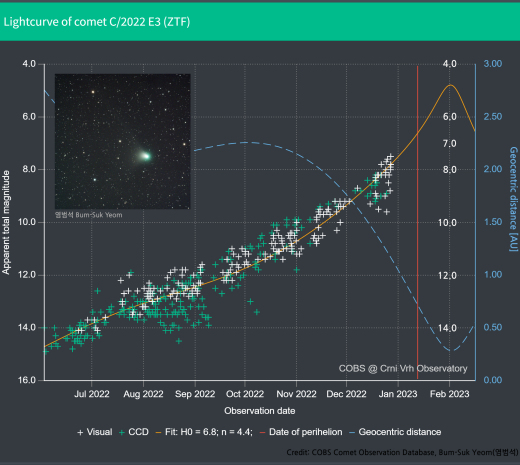
The comet is brightening because it is approaching Earth. Closest approach: 0.28 AU on Feb. 1, 2023. By that time, it will glow like a 5th magnitude star, a naked-eye smudge from dark-sky sites.
The comet is already an easy target for backyard telescopes. Yeom's own photo of the comet is inset in the plot, above. He took it using a 3.5-inch refracting telescope. Currently, the comet is glowing like an 8th magnitude star in the constellation Corona Borealis. Point your optics here.
more images: from Chris Schur of Payson, Arizona; from the Sormano Astronomical Observatory in Italy; from Gregg Ruppel of Animas, New Mexico; from Dalibor Hanžl of Pavlovice, Czech Republic; from Jan Curtis of Oracle, Arizona; from Nello Ruocco of Sorrento, Italy;
THE NORTHERN LIGHTS PENDANT: Are you looking for a far-out gift? Consider this: The Northern Lights Pendant. Here it is, hitching a ride to the stratosphere onboard an Earth to Sky Calculus cosmic ray balloon:
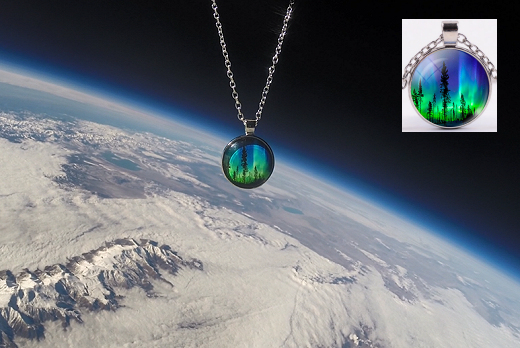
You can have it for $129.95. The students are selling these pendants to support their cosmic ray ballooning program. Each one comes with a greeting card showing the pendant in flight and telling the story of its journey to the edge of space. It makes an out-of-this-world birthday, anniversary, or Mother's Day gift!
Far Out Gifts: Earth to Sky Store
All sales support hands-on STEM education
Realtime Aurora Photo Gallery
Free: Spaceweather.com Newsletter
Every night, a network of
NASA all-sky cameras scans the skies above the United States for meteoritic fireballs. Automated software maintained by NASA's Meteoroid Environment Office calculates their orbits, velocity, penetration depth in Earth's atmosphere and many other characteristics. Daily results are presented here on Spaceweather.com.
On Dec 28, 2022, the network reported 5 fireballs.
(5 sporadics)
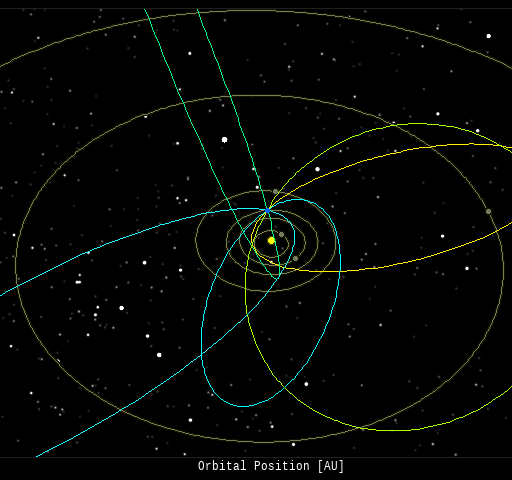
In this diagram of the inner solar system, all of the fireball orbits intersect at a single point--Earth. The orbits are color-coded by velocity, from slow (red) to fast (blue). [Larger image] [movies]
Potentially Hazardous Asteroids (
PHAs) are space rocks larger than approximately 100m that can come closer to Earth than 0.05 AU. None of the known PHAs is on a collision course with our planet, although astronomers are finding
new ones all the time.
On December 28, 2022 there were 2321 potentially hazardous asteroids.
 |
Recent & Upcoming Earth-asteroid encounters: | Asteroid | Date(UT) | Miss Distance | Velocity (km/s) | Diameter (m) |
| 2022 YC4 | 2022-Dec-23 | 1.7 LD | 17.5 | 10 |
| 2022 YN | 2022-Dec-23 | 20 LD | 6.8 | 25 |
| 2022 YB | 2022-Dec-23 | 10.3 LD | 5.8 | 27 |
| 2022 YB6 | 2022-Dec-23 | 18 LD | 8.6 | 16 |
| 2022 YJ3 | 2022-Dec-23 | 12.5 LD | 6.7 | 12 |
| 2022 YO5 | 2022-Dec-24 | 7.6 LD | 9.9 | 42 |
| 2022 YO | 2022-Dec-24 | 3.5 LD | 9.3 | 13 |
| 2022 YY4 | 2022-Dec-24 | 18.3 LD | 8.1 | 21 |
| 2022 YH6 | 2022-Dec-24 | 12.5 LD | 9.2 | 25 |
| 2018 YK2 | 2022-Dec-24 | 9.8 LD | 14.7 | 98 |
| 2022 YZ4 | 2022-Dec-24 | 16.4 LD | 12.4 | 21 |
| 2022 XN | 2022-Dec-24 | 8.5 LD | 11 | 47 |
| 2022 YX2 | 2022-Dec-24 | 0.6 LD | 11.3 | 7 |
| 2022 XM1 | 2022-Dec-24 | 9.7 LD | 12.7 | 31 |
| 2022 YL1 | 2022-Dec-25 | 7.7 LD | 12.2 | 50 |
| 2022 YK3 | 2022-Dec-25 | 1.6 LD | 12.8 | 5 |
| 2022 YY1 | 2022-Dec-25 | 5.2 LD | 14.7 | 22 |
| 2013 YA14 | 2022-Dec-25 | 2.7 LD | 10.5 | 68 |
| 2022 TE14 | 2022-Dec-25 | 11.2 LD | 7 | 127 |
| 2022 YB1 | 2022-Dec-26 | 5.7 LD | 14.8 | 26 |
| 2022 YA6 | 2022-Dec-26 | 0.4 LD | 12.6 | 10 |
| 2022 YH5 | 2022-Dec-26 | 9.1 LD | 15.7 | 18 |
| 2019 LT5 | 2022-Dec-27 | 16.2 LD | 15 | 118 |
| 2022 YY3 | 2022-Dec-27 | 2.6 LD | 8.5 | 9 |
| 2022 YR4 | 2022-Dec-27 | 0.8 LD | 7.7 | 6 |
| 2022 YG1 | 2022-Dec-27 | 11.3 LD | 16.2 | 28 |
| 2022 YF6 | 2022-Dec-27 | 2.5 LD | 19.1 | 18 |
| 2022 WV9 | 2022-Dec-27 | 6.5 LD | 7.3 | 47 |
| 2010 XC15 | 2022-Dec-27 | 2 LD | 10.1 | 182 |
| 2022 XL1 | 2022-Dec-27 | 7.6 LD | 8.4 | 26 |
| 2022 YL | 2022-Dec-27 | 7.9 LD | 5.6 | 18 |
| 2021 AE | 2022-Dec-28 | 16.5 LD | 15 | 23 |
| 2022 YG5 | 2022-Dec-30 | 8.2 LD | 14.2 | 16 |
| 2022 YR1 | 2023-Jan-01 | 16.3 LD | 6 | 23 |
| 2022 YT3 | 2023-Jan-02 | 11.1 LD | 6.4 | 25 |
| 2022 YU3 | 2023-Jan-02 | 9.8 LD | 7.1 | 24 |
| 2022 YP5 | 2023-Jan-02 | 7.8 LD | 4.8 | 14 |
| 2021 NF | 2023-Jan-02 | 17.9 LD | 11.3 | 40 |
| 2022 YJ4 | 2023-Jan-03 | 5.3 LD | 5.6 | 15 |
| 2011 WR41 | 2023-Jan-03 | 15.8 LD | 8.9 | 34 |
| 2019 AY3 | 2023-Jan-04 | 16.8 LD | 19.7 | 62 |
| 2022 YS4 | 2023-Jan-04 | 6 LD | 6.8 | 28 |
| 2022 YL4 | 2023-Jan-05 | 5.2 LD | 2 | 11 |
| 2022 YN1 | 2023-Jan-06 | 18.3 LD | 5.5 | 54 |
| 2021 TL | 2023-Jan-09 | 14.2 LD | 8.5 | 75 |
| 2022 YD5 | 2023-Jan-12 | 8.3 LD | 10.6 | 45 |
| 2022 YZ2 | 2023-Jan-12 | 16.6 LD | 6.5 | 86 |
| 2022 YS5 | 2023-Jan-13 | 15.6 LD | 6 | 42 |
| 2014 LJ | 2023-Jan-14 | 4.8 LD | 3.5 | 7 |
| 2022 YH3 | 2023-Jan-14 | 19 LD | 16.3 | 91 |
| 2012 BV13 | 2023-Jan-16 | 12.2 LD | 6.7 | 134 |
| 2020 BP | 2023-Jan-20 | 5.2 LD | 16.9 | 26 |
| 2019 BO2 | 2023-Jan-24 | 12.1 LD | 16.2 | 21 |
| 2019 BZ4 | 2023-Jan-24 | 16.5 LD | 5.6 | 20 |
| 2020 BZ14 | 2023-Jan-26 | 8.8 LD | 6.7 | 54 |
| 2022 SO113 | 2023-Jan-29 | 10.5 LD | 3.5 | 73 |
| 2017 DU34 | 2023-Feb-02 | 13.3 LD | 11.2 | 16 |
| 367789 | 2023-Feb-03 | 4.7 LD | 9.9 | 149 |
| 2020 OO1 | 2023-Feb-04 | 4.8 LD | 7.7 | 19 |
| 2022 CX1 | 2023-Feb-09 | 17.4 LD | 13.2 | 14 |
| 2021 EP4 | 2023-Feb-13 | 19 LD | 6.1 | 5 |
| 199145 | 2023-Feb-16 | 12 LD | 24.6 | 756 |
| 2022 RG | 2023-Feb-16 | 8.2 LD | 3 | 24 |
| 2020 DG4 | 2023-Feb-17 | 1.4 LD | 6.9 | 8 |
| 2020 CX1 | 2023-Feb-19 | 17.4 LD | 7.7 | 53 |
| 37638 | 2023-Feb-21 | 17 LD | 11.1 | 495 |
Notes: LD means "Lunar Distance." 1 LD = 384,401 km, the distance between Earth and the Moon. 1 LD also equals 0.00256 AU. | | Cosmic Rays in the Atmosphere |
SPACE WEATHER BALLOON DATA: Almost once a week, Spaceweather.com and the students of Earth to Sky Calculus fly space weather balloons to the stratosphere over California. These balloons are equipped with sensors that detect secondary cosmic rays, a form of radiation from space that can penetrate all the way down to Earth's surface. Our monitoring program has been underway without interruption for 7 years, resulting in a unique dataset of in situ atmospheric measurements.
Latest results (July 2022): Atmospheric radiation is decreasing in 2022. Our latest measurements in July 2022 registered a 6-year low:
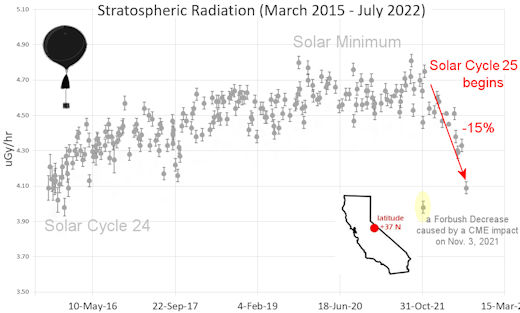
What's going on? Ironically, the radiation drop is caused by increasing solar activity. Solar Cycle 25 has roared to life faster than forecasters expected. The sun's strengthening and increasingly tangled magnetic field repels cosmic rays from deep space. In addition, solar coronal mass ejections (CMEs) sweep aside cosmic rays, causing sharp reductions called "Forbush Decreases." The two effects blend together to bring daily radiation levels down.
.Who cares? Cosmic rays are a surprisingly "down to Earth" form of space weather. They can alter the chemistry of the atmosphere, trigger lightning, and penetrate commercial airplanes. According to a study from the Harvard T.H. Chan school of public health, crews of aircraft have higher rates of cancer than the general population. The researchers listed cosmic rays, irregular sleep habits, and chemical contaminants as leading risk factors. A number of controversial studies (#1, #2, #3, #4) go even further, linking cosmic rays with cardiac arrhythmias and sudden cardiac death.
Technical notes: The radiation sensors onboard our helium balloons detect X-rays and gamma-rays in the energy range 10 keV to 20 MeV. These energies span the range of medical X-ray machines and airport security scanners.
Data points in the graph labeled "Stratospheric Radiation" correspond to the peak of the Regener-Pfotzer maximum, which lies about 67,000 feet above central California. When cosmic rays crash into Earth's atmosphere, they produce a spray of secondary particles that is most intense at the entrance to the stratosphere. Physicists Eric Regener and Georg Pfotzer discovered the maximum using balloons in the 1930s and it is what we are measuring today.
| | The official U.S. government space weather bureau |
| | The first place to look for information about sundogs, pillars, rainbows and related phenomena. |
| | Researchers call it a "Hubble for the sun." SDO is the most advanced solar observatory ever. |
| | 3D views of the sun from NASA's Solar and Terrestrial Relations Observatory |
| | Realtime and archival images of the Sun from SOHO. |
| | information about sunspots based on the latest NOAA/USAF Active Region Summary |
| | current counts of failed and deployed Starlink satellites from Jonathan's Space Page |
| | Authoritative predictions of space junk and satellite re-entries |
| | from the NOAA Space Environment Center |
| | fun to read, but should be taken with a grain of salt! Forecasts looking ahead more than a few days are often wrong. |
| | from the NOAA Space Environment Center |
| | the underlying science of space weather |
 | BestCSGOGambling is the best site for everything related to CSGO gambling on the web |
 | To find reviews of new online casino sites in the UK try The Casino DB where there are hundreds of online casino reviews complete with bonuses and ratings. Alternatively, Online-Casinos.xyz is another massive directory of online casinos listing sites for the UK and Worldwide. Casinos that offer Rupees for bonuses are very generous to Indian players. Find the best online casinos in India at AllCasinos.in Looking for a new online casino? Try Casimpo the new site dedicated to making online casino simple, or check out the new Avenger Slots Casino and Ace Online Casino with over 500 online slots and casino games. |
 | When looking for casinos to play online when the weather is bad, you can try casino online trucchi for Italian games. If you are not from Finland you can try the Swedish page Svenska casino online to find suitable games, check out svenskacasinoonline.net. Always check your local laws before playing with real money. |
 | Looking for sports betting companies not registered on GamStop? CasinoGap has presented a list of sites not on GamStop available for UK players. Check and bet online! Would you like to bet at sites not using GamStop? Look at a list of NonStopCasino sites for online betting that aren't on GamStop. Top-rated bookmakers ever! |
| | These links help Spaceweather.com stay online. Thank you to our supporters! |
| | | | | | |

